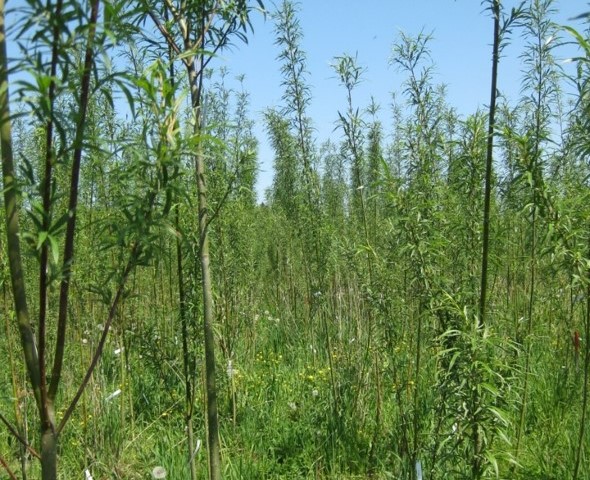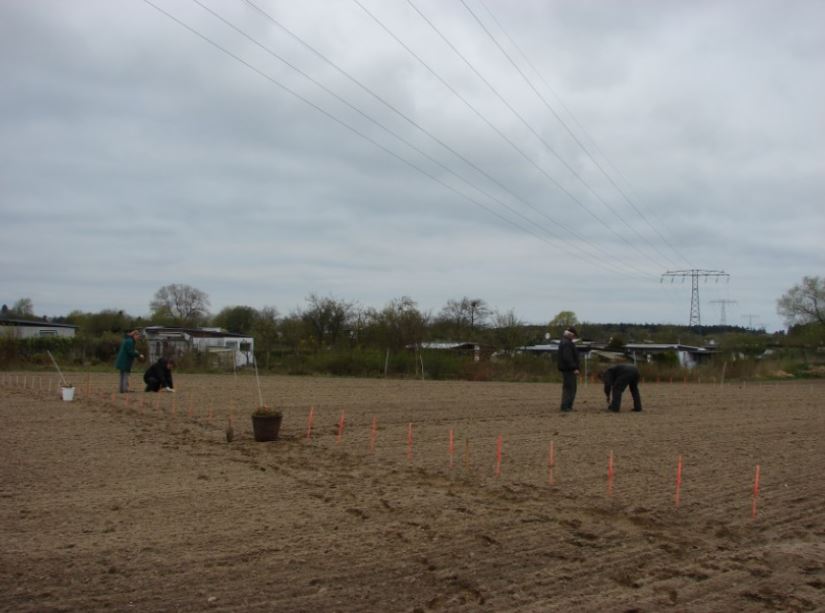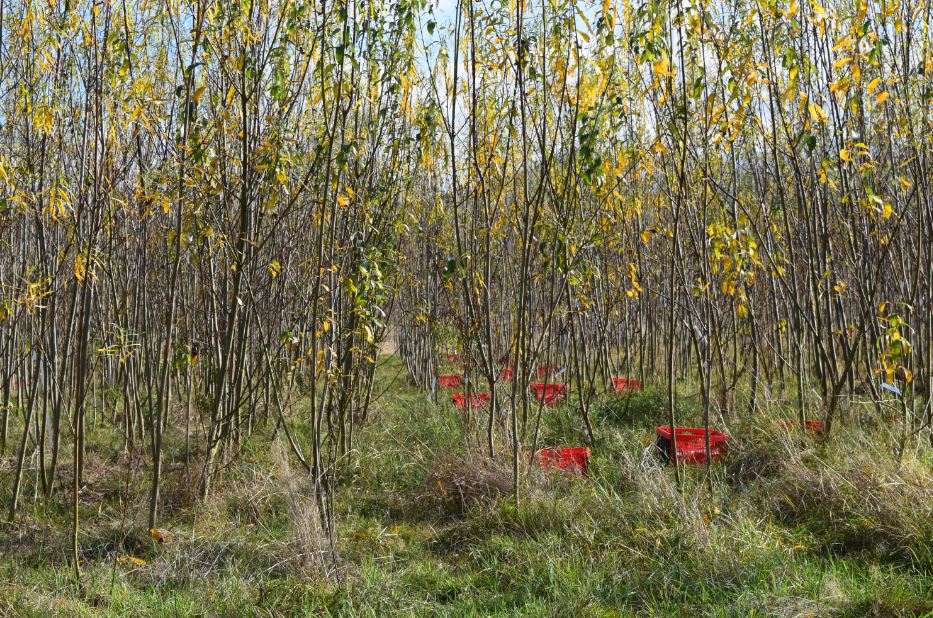ECOLINK-Salix (Zweden)
The three experimental field sites of ECOLINK-Salix have been established along a 1500 km latitudinal gradient, from Uppsala (Sweden) to Rostock and Freiburg (Germany), in spring 2014. In 2020 the Freiburg site was abandoned. Now the ECOLINK-Salix experiment consists of two sites. The plantations are short rotation coppice stands. Shoot biomass was harvested for the first time after three years of growth (in winter 2016/2017). The overall goal of ECOLINK-Salix is assessing the effects of genotype identity and diversity in willow short rotation coppice on various ecosystem functions and, ultimately, tree growth and yield stability (e.g. resistance to drought and pests). Particular focus lies on functions that are important for ecological sustainability, such as water and nutrient use, carbon sequestration, and biodiversity.
Design
The experiment has a randomized block design, with three replicates (blocks). Salix varieties, i.e., genotypes, with known characteristics and different taxonomic relationships (full siblings to different species) were planted in all theoretically possible combinations: plots with single varieties, mixtures of two, three, and four varieties. The diversity treatments were assigned randomly to plots within a block. Four Salix varieties were planted - from near to more remote taxonomic relationship:
- ‘Tora’ (Svalöf-Weibull (SW) cultivar no. 910007, S. schwerinii × S. viminalis)
- ‘Björn’ (SW 910006, Salix schwerinii E. Wolf. × S. viminalis L.)
- ‘Jorr’ (SW 880013, S. viminalis)
- ‘Loden’ (SW 890129, S. dasyclados) All four varieties are grown in Uppsala and Freiburg; only ‘Tora’ and ‘Loden’ are grown at the Rostock site..


Site characteristics
| ECOLINK-Salix (Uppsala) | ECOLINK-Salix (Rostock) | ECOLINK-Salix (Freiburg) | |
|---|---|---|---|
| Country | Sweden | Germany | Germany |
| Biome | temperate | temperate | temperate |
| Latitude | 59.82 | 54.05 | 48.01893861 |
| Longitude | 17.67 | 12.08 | 7.827087438 |
| Soil type | vertic cambisol | stagnic cambisol | cambisol |
| Former land use | arable | arable | grassland (sheep grazing) |
| Altitude | 12 m | 13 m | 230 m |
| Design | regular (2 genotypes), randomized within rows (3, and 4 genotypes) | regular (2 genotypes), randomized within rows (3, and 4 genotypes) | regular (2 genotypes), randomized within rows (3, and 4 genotypes) |
| Plot shape | square | square | square |
| Plot size (m^2) | 92.16 m² | 92.16 m131 | 92.16 m132 |
| Plant distance (m) | 0.8 | 0.8 | 0.8 |
| Number of trees planted | 6480 | 1296 | 6480 |
| Planting date | 2014 | 2014 | 2014 |
| Diversity variables | genetic diversity | genetic diversity | genetic diversity |
| Diversity gradient | 1-4 varieties | 1-2 varieties | 1-4 varieties |
| Size species pool | 4 | 2 | 4 |
| Species pool | Salix schwerinii × Salix viminalis Salix schwerinii × Salix viminalis Salix viminalis Salix dasyclados |
Salix schwerinii × Salix viminalis Salix dasyclados |
Salix schwerinii × Salix viminalis Salix schwerinii × Salix viminalis Salix viminalis Salix dasyclados |
| Contact person | Martin Weih | Christel Baum | Michael Scherer-Lorenzen |
| martin.weih@slu.se | christel.baum@uni-rostock.de | michael.scherer@biologie.uni-freiburg.de |
Research
We will test the ecosystem consequences of adding individual genotypes of trees. We want to functionally and quantitatively explore how the heritable traits of some genotypes of Salix affect (1) ecosystem productivity, litter decomposition and soil carbon sequestration; (2) the abundance and structure of associated mycorrhiza communities; (3) the action of herbivorous insects; and (4) the diversity and function of understory vegetation. At individual sites, additional research questions will be conducted, e.g. on resource use complementarity, soil hydrology or wood quality. The research will have implications for future bio-energy concepts because new genotypes of energy crops such as Salix generated by plant breeding must comply with sustainability requirements, e.g., biodiversity and carbon sequestration, for a carbon-neutral and environmentally friendly energy source, e.g. Weih et al. (2014).
Watch this talk for a summary of our research on species or genotype identiy vs. stand diversity in Salix biomass plantations for productivity and other ecosystem functions (26th IPC session, October 2021).
Extra information
Send an e-mail to the contact persons or explore the publications that utilized data from this experiment.
PhD thesis
- Arranz C 2020 Use of mixtures in short rotation coppice plantations to increase productivity. PhD thesis, University of Freiburg
- Hoeber S 2019 Biodiversity-ecosystem function in a willow biomass production system. PhD thesis, Uppsala: Sveriges lantbruksuniv., Acta Universitatis Agriculturae Sueciae, 1652-6880.
Research papers
- Blondeel H, Guillemot J, Martin‐StPaul N, Druel A, Bilodeau‐Gauthier S, Bauhus J, … Baeten L 2024 Tree diversity reduces variability in sapling survival under drought. Journal of Ecology 112(5): 1164-1180 - https://doi.org/10.1111/1365-2745.14294
- Jing X, Baum C, Castagneyrol B, Eisenhauer N, Ferlian O, Gebauer T, Hajek P, Jactel H, Muys B, Nock C, Ponette Q, Rose L, Saurer M, Scherer-Lorenzen M, Verheyen K, van Meerbeek K 2024 Leaf isotopes reveal tree diversity effects on the functional responses to the pan-European 2018 summer drought. New Phytologist 243:1312-1328 - doi: 10.1111/nph.19931
- Depauw L, De Lombaerde E, Dhiedt E, Blondeel H, Abdala-Roberts L, Auge H, Barsoum N, Bauhus J, Chu C, Damtew A, Eisenhauer N, V. Fagundes M, Ganade G, Gendreau-Berthiaume B, Godbold D, Gravel D, Guillemot J, Hajek P, Hector A, Hérault B, Jactel H, Koricheva J, Kreft H, Liu X, Mereu S, Messier C, Muys B, Nock CA, Paquette A, Parker JD, Parker WC, Paterno, GB, Perring MP, Ponette Q, Potvin C, Reich PB, Rewald B, Scherer-Lorenzen M, Schnabel F, Sousa-Silva R, Weih M, Clara Zemp D, Verheyen K, Baeten L 2024 Enhancing Tree Performance Through Species Mixing: Review of a Quarter-Century of TreeDivNet Experiments Reveals Research Gaps and Practical Insights. Current Forestry Reports - https://doi.org/10.1007/s40725-023-00208-y
- FAO 2023 Towards more resilient and diverse planted forests. Unasylva (254)74: 2031/1. Rome. https://doi. org/10.4060/cc8584en
- Lindh M, Hoeber S, Weih M, Manzoni S 2022 Interactions of nutrient and water availability control growth and diversity effects in a Salix two-species mixture. Ecohydrology e2401 https://onlinelibrary.wiley.com/doi/10.1002/eco.2401
- Hoeber S , Baum C, Weih M, Manzoni S, Fransson P 2021 Site-dependent relationships between fungal community composition, plant genotypic diversity and environmental drivers in a Salix biomass system. Frontiers in Fungal Biology, section Fungi-Plant Interactions 2: 671270 - https://doi.org/10.3389/ffunb.2021.671270
- Koczorski P, Furtado B, Hrynkiewicz K, Breezmann M, Weih M, Baum C 2021 Site-effects dominate the plant-availability of nutrients under Salix species during the first cutting cycle. Forests 12: 1226 - https://doi.org/10.3390/f12091226
- Koczorski P, Furtado BU, Gołebiewski M, Hulisz P, Baum C, Weih M, Hrynkiewicz K 2021 The effects of host plant genotype and environmental conditions on fungal community composition and phosphorus solubilization in willow short rotation coppice. Frontiers in Plant Science 12: 647709 - https://doi.org/10.3389/fpls.2021.647709
- Kollberg I, Weih M, Glynn C 2021 The effect of willow diversity on insect herbivory and predation. Agricultural and Forest Entomology (online). https://doi.org/10.1111/afe.12466
- Kwon T, Shibata H, Kepfer-Rojas S, Schmidt IK, Larsen KS, Beier C, Berg B, Verheyen K, Lamarque J-F, Hagedorn F, Eisenhauer N, Djukic I, TeaCompositionNetwork 2021 Effects of climate and atmospheric nitrogen deposition on early to mid-term stage litter decomposition across biomes. Frontiers in Forests and Global Change 4: 678480 - https://doi.org/10.3389/ffgc.2021.678480
- Weih M, Nordh N-E, Manzoni S, Hoeber S 2021 Functional traits of individual varieties as determinants of growth and nitrogen use patterns in mixed stands of willow (Salix spp.). Forest Ecology and Management 479 - https://doi.org/10.1016/j.foreco.2020.118605
- Messier C, Bauhus J, Sousa-Silva R, Auge H, Baeten L, Barsoum N, Bruelheide H, Caldwell B, Cavender-Bares J, Dhiedt E, Eisenhauer N, Ganade G, Gravel D, Guillemot J, Hall JS, Hector A, Hérault B, Jactel H, Koricheva J, Kreft H, Mereu S, Muys B, Nock CA, Paquette A, Parker JD, Perring MP, Ponette Q, Potvin C, Reich PB, Scherer-Lorenzen M, Schnabel F, Verheyen K, Weih M, Wollni M, Zemp DC 2021 For the sake of resilience and multifunctionality, let’s diversify planted forests! Conservation Letters e12829 - https://doi.org/10.1111/conl.12829
- Hoeber S, Fransson P, Weih M, Manzoni S 2020 Leaf litter quality coupled to Salix variety drives litter decomposition more than stand diversity or climate. Plant and Soil 453:313-328 - 10.1007/s11104-020-04606-0
- Khokthong W 2019 Drone-based assessments of crowns, canopy cover and land use types in and around an oil palm agroforestry experiment. PhD Thesis, University Of Göttingen.
- Schweier J, Arranz C, Nock C A, Jaeger D, Scherer-Lorenzen M 2019 Impact of Increased genotype or species diversity in short rotation coppice on biomass production and wood characteristics. BioEnergy Research 12: 497-508 - https://doi.org/10.1007/s12155-019-09997-2
- Weih M, Glynn C, Baum C 2019 Willow short-rotation coppice as model system for exploring ecological theory on biodiversity–ecosystem function. Diversity 11(8): 125 - https://doi.org/10.3390/d11080125
- Baum C, Hrynkiewicz K, Szymanska S, Vitow N, Hoeber S, Fransson PMA, Weih M 2018 Mixture of Salix genotypes promotes root colonization with dark septate endophytes and changes P cycling in the mycorrhizosphere. Frontiers in Microbiology 9: 1012 - doi: 10.3389/fmicb.2018.01012
- Djukic I, Kepfer-Rojas S, Kappel Schmidt I, Steenberg Larsen K, Beier C, Berg B, Verheyen K, TeaComposition 2018 Early stage litter decomposition across biomes. Science of the Total Environment 628-629: 1369-1394 - doi: 10.1016/j.scitotenv.2018.01.012
- Hoeber S, Arranz C, Nordh N-E, Baum C, Low M, Nock C, Scherer-Lorenzen M, & Weih M 2018 Genotype identity has a more important influence than genotype diversity on shoot biomass productivity in willow short-rotation coppices. GCB Bioenergy, 10(8): 534-547 - https://doi.org/10.1111/gcbb.12521
- Müller M, Klein A-M, Scherer-Lorenzen M, Nock CA, Staab M 2018 Tree genetic diversity increases arthropod diversity in willow short rotation coppice. Biomass and Bioenergy 108: 338-344 - doi:10.1016/j.biombioe.2017.12.001
- Hoeber S, Fransson P, Prieto-Ruiz I, Manzoni S, Weih M 2017 Two Salix genotypes differ in productivity and nitrogen economy when grown in monoculture and mixture. Frontiers in Plant Science 8: 231 - doi: 10.3389/fpls.2017.00231
- Gérard A 2016 Experimental biodiversity enrichment in an oil-palm plantation. PhD thesis, University Of Göttingen.
- Teusher M 2015 Ecological impacts of biodiversity enrichment in oil palm plantations. PhD Thesis, University Of Göttingen.



The Uppsala site during the third growing season (May 2016), the Rostock site at the time of establishment (April 2014), and the Freiburg site after the third growing season (October 2016)
Funding
The ECOLINK-Salix project was funded by the Swedish Energy Agency (project no. 36654-11 and 36654-2) and the Swedish Research Council Formas (projects no. 2016-00998 and 2020-02339). In addition, the trial in Freiburg was supported financially through the “Innovationsfonds Forschung” of the Freiburg University for the project “Mechanisms of tree diversity effects on ecosystem functioning, and through the”Forschungsprogramm Bioökonomie” of the state of Baden-Württemberg for the project “Hochdivers-KUP: Nutzung von Baum-Diversität zur Erhöhung der Produktivität und ökologischen Stabilität von Kurzumtriebsplantagen”
